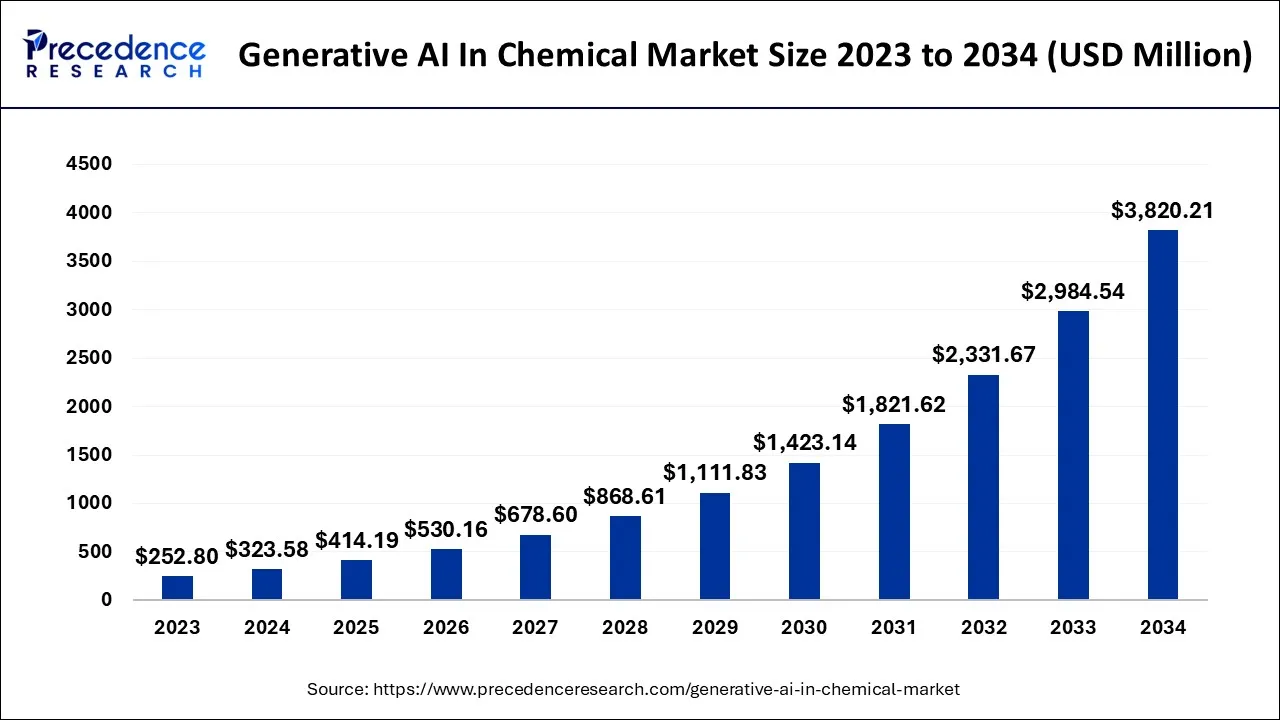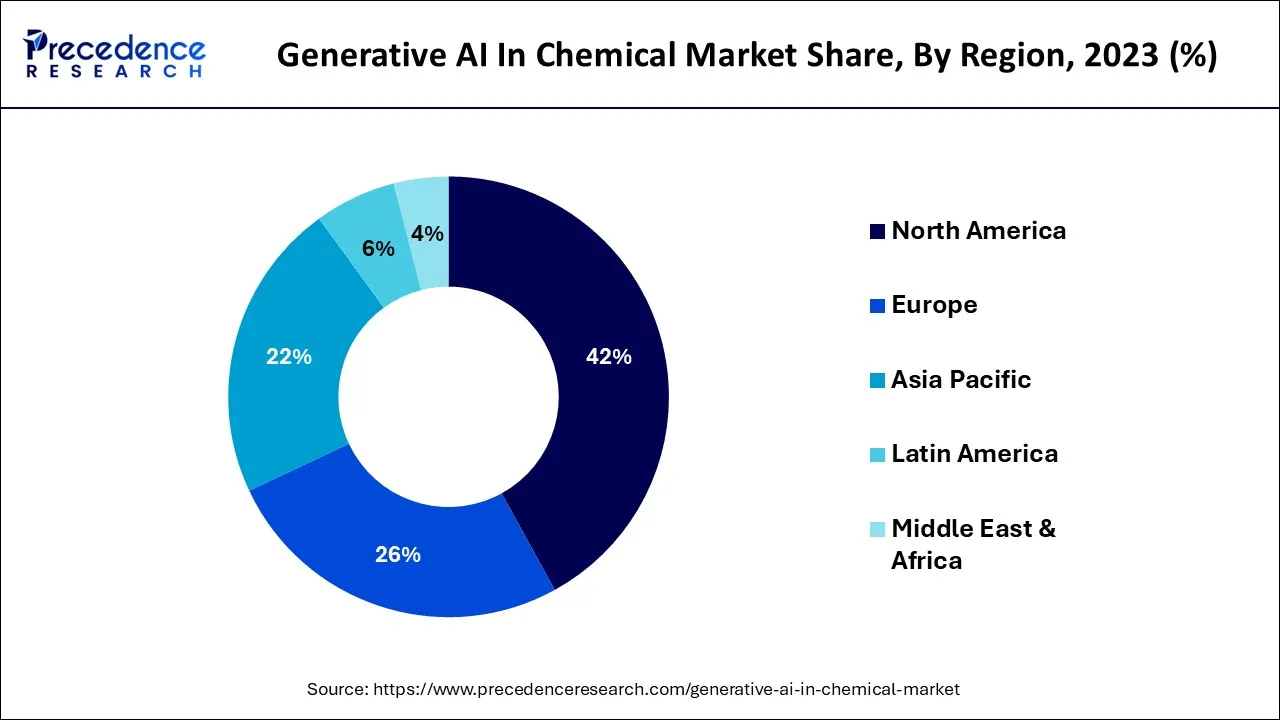January 2025
The global generative AI in chemical market size is calculated at USD 323.58 million in 2024, grew to USD 414.19 million in 2025, and is predicted to hit around USD 3,820.21 million by 2034, expanding at a CAGR of 28% between 2024 and 2034. The North America generative AI in chemical market size accounted for USD 135.90 million in 2024 and is anticipated to grow at the fastest CAGR of 28.15% during the forecast year.
The global generative AI in chemical market size is worth around USD 323.58 million in 2024 and is anticipated to reach around USD 3,820.21 million by 2034, growing at a CAGR of 28% over the forecast period from 2024 to 2034.

North America is expected to dominate the market over the forecast period. Generative AI has made significant strides in the field of chemistry, and its applications have attracted attention in the chemical market worldwide, including in North America. The chemical industry in North America is a major player in global markets, encompassing various sectors such as pharmaceuticals, specialty chemicals, polymers, and materials science. Generative AI offers unique opportunities for innovation and efficiency within these sectors. In the pharmaceutical industry, generative AI models have the potential to transform the drug discovery process. Traditional methods of developing new drugs are often time-consuming and expensive, with a high failure rate. Generative AI models can expedite the process by generating novel molecules with desired drug-like properties. This technology enables researchers to explore a vast chemical space more efficiently, leading to the identification of promising drug candidates.
North American pharmaceutical companies have shown a keen interest in incorporating generative AI into their drug discovery pipelines to accelerate the development of new therapeutics. For instance, each stage of the preclinical drug development process was carried out by Insilico using generative AI, including identifying a molecule that a therapeutic compound may target, creating new drug candidates, evaluating how effectively these candidates would bind with the target, and even forecasting the results of clinical trials.

Traditional methods would have required up to six years and cost more than $400 million to complete. However, by using generative AI, Insilico was able to complete them in a third of the time and for a tenth of the cost, and only two and a half years after the project's inception, it had reached the first stage of clinical testing. Thus, the increasing utilization of generative AI in the pharmaceutical sector in the region is expected to drive market growth over the forecast period.
Asia Pacific is expected to grow at the fastest rate over the forecast period. Generative AI has gained significant traction in the chemical market worldwide, including the Asia Pacific region. The chemical industry in Asia Pacific is one of the largest and fastest-growing globally, encompassing diverse sectors such as petrochemicals, pharmaceuticals, specialty chemicals, and materials science. Generative AI offers unique opportunities for innovation, efficiency, and competitiveness within these sectors. In the pharmaceutical industry, generative AI has the potential to revolutionize drug discovery and development processes. Asia Pacific countries, such as China, India, and Japan, are major players in the global pharmaceutical market.
Generative AI models can aid in the design and optimization of drug candidates by generating novel molecules with desired properties. This technology enables researchers to explore vast chemical spaces, accelerating the identification of potential therapeutic candidates. Pharmaceutical companies in the Asia Pacific are actively exploring and adopting generative AI approaches to streamline drug discovery and enhance their competitive position in the global market. For instance, in May 2023, Sumitomo Pharma Co., Ltd. ('Sumitomo Pharma') announced that it intends to start a Phase 1 clinical investigation of DSP-2342 in the United States, according to a recent announcement from Exscientia plc. DSP-2342 is a strong dual 5-HT2A and 5-HT7 antagonist small molecule with extensive application potential in mental disorders. It is highly selective and bispecific. It is the third chemical produced using Exscientia's AI-driven drug discovery platform, or design as a service, in a partnership with Sumitomo Pharma.
Generative artificial intelligence (AI) is revolutionizing various industries, and the chemical market is no exception. Generative AI refers to a subset of AI that involves the creation of new content, such as images, text, or even chemical compounds, based on patterns and examples observed in existing data. This innovative technology has the potential to transform the chemical market by accelerating the discovery and design of novel molecules, improving the efficiency of drug development, optimizing chemical processes, and aiding in materials discovery.
Generative AI models are trained on vast amounts of chemical data, including molecular structures, properties, and reactions. These models learn the underlying patterns and relationships within the data and can generate new chemical structures and designs with specific properties or characteristics. This ability to generate new molecules has tremendous implications for drug discovery, materials science, and various other applications in the chemical industry. For instance, in drug discovery, generative AI models can be used to generate new drug candidates based on desired properties, such as efficacy, safety, and specificity.
The models of generative AI can explore vast chemical spaces and propose novel molecules with potential therapeutic benefits. This accelerates the drug discovery process and helps identify promising candidates for further experimentation and development. The global generative AI in the chemical market is driven by several factors including increasing utilization of AI in drug discovery, product launch, increasing investment and growing pharmaceutical industry.
| Report Coverage | Details |
| Market Size in 2024 | USD 323.58 Million |
| Market Size by 2034 | USD 3,820.21 Million |
| Growth Rate from 2024 to 2034 | CAGR of 28% |
| Largest Market | North America |
| Base Year | 2023 |
| Forecast Period | 2024 to 2034 |
| Segments Covered | By Technology and By Application |
| Regions Covered | North America, Europe, Asia-Pacific, Latin America, and Middle East & Africa |
The increasing digitalization of the drug discovery process
The clinical drug discovery procedures' digitalization is a key factor in the market's expansion. In the field of computational biology, the use of big data and AI with stage modeling, lead selection, and optimization phases is beneficial to the drug development process. The analysis of large data sets from the fields of pharmaceutical, chemical, biological, and clinical research has benefited from the use of digital technologies.
For instance, Monash University of Australia used big data in November 2022. This type of data may be reused for use in larger medical applications, such as the repurposing of thalidomide for multiple myeloma and dimethyl fumarate for multiple sclerosis. In addition, the first dosage of the medication VRG50635 for the treatment of amyotrophic lateral sclerosis was announced by Verge Genomics in October 2022, a clinical-stage and tech-enabled biotechnology business that uses AI for drug research reasons. Therefore, this type of instance is expected to drive market growth over the forecast period.
Data quality and quantity
Generative AI models rely heavily on large and high-quality datasets for training. However, acquiring such datasets in the chemical industry can be challenging. Data on chemical structures, properties, and reactions may be limited or proprietary, making it difficult to train accurate and reliable models. Insufficient or biased data can lead to poor model performance and inaccurate generated outputs. Therefore, this is expected to act as a major restraint for the market growth over the forecast period.
The growing pharmaceutical industry coupled with the increasing prevalence of chronic disease
The growing pharmaceutical industry coupled with the increasing prevalence of chronic disease is expected to propel the growth of generative AI in chemical market during the forecast period. India holds a significant place in the world's pharmaceutical industry. The nation also possesses a sizable pool of scientists and engineers that might propel the sector forward to new heights. Currently, Indian pharmaceutical companies offer approximately 80% of the antiretroviral medications needed to treat AIDS across the globe.
In addition, as per the American Cancer Society, globally, it is anticipated that by 2040 there would be 16.3 million cancer deaths and 27.5 million new cancer cases worldwide. Thereby, increasing chronic disease along with growing pharmaceuticals is expected to offer a lucrative opportunity for market expansion during the forecast period.
Based on the technology, the global generative AI in chemical market is segmented into machine learning, reinforcement learning, deep learning, molecular docking and quantum computing. The deep learning segment is expected to capture a significant market share over the forecast period. A crucial component of the generative AI used in the drug discovery market is deep learning. It is essential for determining characteristics, optimizing medicine candidates, and evaluating molecular structures.
By using them, unique compounds with desired characteristics can be created. These algorithms produce promising ideas for drug development by learning from vast databases of chemical structures and characteristics. Deep generative models are used to create molecules with certain properties, including generative adversarial networks (GANs) and variational autoencoders (VAEs). Furthermore, virtual screening, which analyzes huge chemical libraries to find compounds with a high potential for action against certain targets, makes use of these techniques. All these factors promote the segment’s growth.
Based on the application, the global generative AI in chemical market is segmented into the discovery of new materials, production optimization, pricing optimization, load forecasting of raw materials, product portfolio optimization, feedstock optimization and process management & control. The discovery of new materials segment is expected to dominate the market over the forecast period. Generative AI is playing a significant role in the discovery and design of new materials in the chemical market. These models are used to optimize material properties by exploring vast chemical spaces and proposing novel compositions and structures. This segment focuses on improving specific properties such as strength, conductivity, flexibility, or thermal stability. Generative models analyze existing materials and their properties to suggest new compositions with enhanced performance characteristics. Thereby, driving market expansion.
Segments Covered in the Report
By Technology
By Application
By Geography
For inquiries regarding discounts, bulk purchases, or customization requests, please contact us at sales@precedenceresearch.com
No cookie-cutter, only authentic analysis – take the 1st step to become a Precedence Research client
January 2025
July 2024
September 2024
January 2025